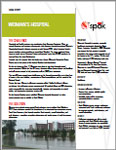Case studies
Woman’s Hospital
Overview
Woman’s Hospital is a private, nonprofit healthcare organization located in Baton Rouge, Louisiana. Founded in 1968, Woman’s was among the first women’s specialty hospitals in the nation and is currently one of the largest in the U.S., ranking 17th for total births, with over 8,100 deliveries each year.
Designated a Nursing Magnet® hospital and accredited by The Joint Commission, Woman’s is a Level III Regional Obstetrics Unit and Neonatal Intensive Care Unit, with 252 beds and more than 2,000 employees.
Industry
- Healthcare
Solution
- Secure messaging integrated with call center solutions for operator console, web directory, and on-call scheduling
Business drivers
- Improve call center efficiency
- Support fast, secure, reliable mobile communications
- Establish audit trail for messages, particularly delivery receipts
Results
- Call center operators can reach providers with secure messaging when other forms of communication are unavailable
- Staff send, receive, and accept messages in as little as 15-30 seconds
The challenge
Hospitals and health systems are reevaluating their business continuity plans as natural disasters and growing cybersecurity risks threaten hospital operations. Woman’s Hospital confronted a disaster scenario in early August 2016 when Louisiana faced a severe weather system resulting in record-level flooding. The storm produced three times as much rain as Hurricane Katrina and more than 30,000 people needed rescuing from the rising floodwaters.
Located near a lake that feeds into a bayou, Woman’s Hospital in Baton Rouge was at the center of the historic flooding and devastation.
As the rain began on Aug. 11, Woman’s was about to test their hospital critical communications. Within the first 24 hours, physician offices began closing and landlines and cell service started to fail, preventing calls or [SMS] text messages.
The next 36 hours proved more challenging as the hospital prepared for up to three feet of water in the main building, construction of flood control dams, and the arrival of the National Guard.
During this time, Woman’s call center operators rallied. Staffed by fifteen full-time employees, the call center serves approximately 50 medical offices and 300 physicians and is responsible for answering hospital calls, initiating and responding to critical codes, and processing answering service calls.
As the historic flooding event unfolded, Woman’s Hospital discovered no other communication was as reliable as Spok secure messaging.
During the flood, we really put our hospital communication infrastructure to the test, including our Spok solutions.
– Monica Parish, Director of Patient Services
The solution
Woman’s was already using several Spok solutions prior to adding secure messaging in 2011. These solutions provided the foundation of an integrated communication system, Spok Care Connect®, that brought together Spok console, on-call scheduling, and web directory—providing up-to-date information and a single source of truth for contact information.
Monica Parish, Director of Patient Services at Woman’s, reflects on the key challenges the hospital faced: “We were unable to communicate with staff and physicians due to the widespread and sporadic phone outages. As the water continued to rise, our staff members were unable to get to work and call volume increased.”
Over a quarter of employees experienced personal property damage, 14% requested and received a disaster leave of absence, and 55% of the hospital’s operators were impacted. In addition, 11 major wireless carrier cell towers were down, and other carriers experienced intermittent issues. “We had no way of knowing whether [SMS] text messages to a person’s cell phone were received,” explains Parish.
Woman’s selected Spok for its HIPAA compliance and ability to improve efficiency. “Spok Mobile was the only option that offered all the features we needed—and more,” says Parish.
The result
During the disastrous flooding, secure messaging became the de facto communication method for operators to deliver messages quickly, allowing them to easily handle the influx of calls.
Normally averaging 21,000 calls per month, Woman’s experienced a 27% increase in call center volume in August 2016. That had operators handling approximately 5,600 additional calls.
Using secure messaging, operators could determine which physicians were available, reach them via secure message, and confirm whether the message was received. Prior to Spok, operators at Woman’s had no way to confirm whether doctors received messages. “Patients would call us because they hadn’t heard from their doctor, so we’d try contacting the doctor, and sometimes even call the patient back to ask if the doctor had called them yet,” explains Parish.
With Spok secure messaging, Parish estimates it takes no more than 15 to 30 seconds to send a message and receive the acceptance from the doctor. “That’s if the doctor immediately responds, which the majority do since it only takes one tap to accept,” Parish notes.
The future
Woman’s learned valuable lessons, all of which are informing their next steps. In the future, Woman’s is looking to Spok to help improve their communication with hospital administration, by expanding the use of secure messaging to include the leadership team.
They’re also considering Spok’s mass notification solution to help quickly and reliably notify staff during emergency situations. In the aftermath of unpredictable and dangerous flooding, Woman’s realized the need for fast, accurate notification of critical information during emergency situations.
“As an additional communication tool, we’re considering emergency notifications to eliminate calling trees and confusion,” says Parish. “As we consider our future disaster recovery plans, we need to know we can reach our people on their mobile devices and verify responses. When time matters, we’re relying on our Spok solutions for dependable, accurate communications.”




